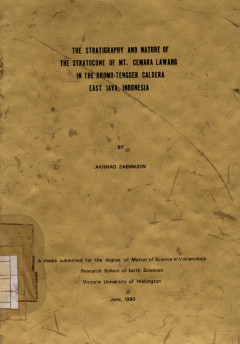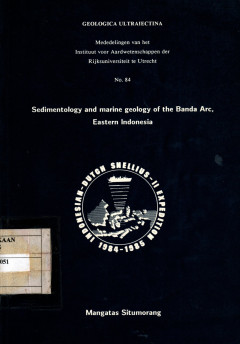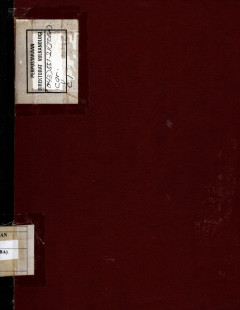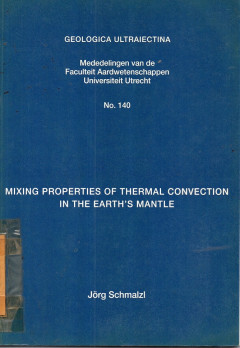Ditapis dengan

Geology of Krakatau Complex
The Krakatau complex situated in the Sunda Strait, as a part of the Lampung Province (105°21'20" - 105°27'44" E. Long/6°03'0 2, Lot.), consists of four islands: Rakata, Sortung, Panjang and Anak Krakatau. The bordering sides facing each other at Nakata, Sertung and Panjong show a steep morphology which forms the enlders wall, at none places revealing faults. The chronology of the volcanic…
- Edisi
- -
- ISBN/ISSN
- -
- Deskripsi Fisik
- 24 hlm; gmbr; peta
- Judul Seri
- -
- No. Panggil
- PVG A.83-91

A Government Of New Zealand Aid Project With The Government Of Indonesia Geot…
- Edisi
- -
- ISBN/ISSN
- -
- Deskripsi Fisik
- 95 Halaman, Tanpa Warna, Cover Biru, Tanpa Peta
- Judul Seri
- -
- No. Panggil
- PMB LE 1968 - 11 NL
- Edisi
- -
- ISBN/ISSN
- -
- Deskripsi Fisik
- 95 Halaman, Tanpa Warna, Cover Biru, Tanpa Peta
- Judul Seri
- -
- No. Panggil
- PMB LE 1968 - 11 NL

Introduction to Sabo Works
The change of seasons is most clearly distinguishable in the appearances of mountains. Councurrently with snow-melting, the yellowish green colored sprouts of plants attract our attention and tell us the advent of spring on mountains. And when the leaves change their colour from fresh green to dark green, we are informed that the rainy seasons is over and the summer is setting in.
- Edisi
- -
- ISBN/ISSN
- -
- Deskripsi Fisik
- 166 hal.; gbr.
- Judul Seri
- -
- No. Panggil
- PVG 551.21 IKE I c.1

The Stratigraphy And Nature Of The Stratoone Of Mt. Cemara Lawang In The Brom…
The statocone of Mt. Cemara Lawang is part of The Mt. Bromo-Tengger volcano complex, East Java, Indonesia. Mt. Cemara Lawang is comosed of a sequences of deposits, comprising the big feldspar lava, andesite lava, phreatomagmatic ash fall, phreatic, basalt lava, basaltic andesite lava, andesite lava, alternating layers of pyroclastic fall and flow and the brown ash fall deposits from the oldest …
- Edisi
- -
- ISBN/ISSN
- -
- Deskripsi Fisik
- 228 hal.; gbr.; tabel; foto
- Judul Seri
- -
- No. Panggil
- PVG (043)551.7(E3) ZAE s c.1

Sedimentology and Marine Geology of The Banda Arc, Eastern Indonesia
Tujuan dari studi ini adalah menganalisa dan mengkaitkan aspek-aspek sedimentologi, petrologi serta sifat geoteknik daripada fasies batuan dasar laut Kuarter yang diendapkan di dalam cekungan tektonik aktip di daerah Laut Banda.
- Edisi
- -
- ISBN/ISSN
- 90-71577-39-2
- Deskripsi Fisik
- 191 hal,; gbr.; lamp.; tabel.
- Judul Seri
- -
- No. Panggil
- PVG (043)551.3.051 SIT s c.1

Marine Geology and Tectonic Development of the Banda Sea Region Eastern Indon…
The origin of the Banda Sea region is critical to the tectonic development of eastern Indonesia. The purpose of this study is to synthesize the existing geological and geophysical data into a tectonic model of the Banda Sea Region, as an example of a marginal basin developed within and active arc-continent collision.
- Edisi
- -
- ISBN/ISSN
- -
- Deskripsi Fisik
- 415 hal,; gbr.; lamp.; tabel.
- Judul Seri
- -
- No. Panggil
- PVG (043)550 PRA m c.1

La Methode de Polarisation Spontanee Applique L'Hydrologeologie en Region Vol…
Ce travail a pout objet 1 etude de la circulation des eaux soterraines dans formations volcaniques pas methode PS.
- Edisi
- -
- ISBN/ISSN
- -
- Deskripsi Fisik
- 56 hal,; gbr.; tabel.
- Judul Seri
- -
- No. Panggil
- PVG (043)551.21 DAN I c.1

Volcanology of The Youngest Toba Tuff, Sumatera
The Toba depression in northern Sumatera is a complex structure, formed by repeated episodes of caldera subsidence and resurgence, strongly influenced by regional structure. The Toba depression, and the associated Toba Tuff, a widespread ignimbrite sheet which covers approximately 20.000km, are the result of three major eruptive events.
- Edisi
- -
- ISBN/ISSN
- -
- Deskripsi Fisik
- 168 hal,; tabel; gbr.
- Judul Seri
- -
- No. Panggil
- PVG (043)551.21 CAR v c.1

Volcanic Geology of Galunggung West Java, Indonesia (Book I)
Galunggung volcanic rocks are included within the Galunggung Group and can be divided into old Galunggung formation, Tasikmalaya Formation and Cibanjaran formation. The firs formation represents rocks of old Galunggung stratovolcano (50.000 - 10.000 yrs. BP?), the second formation covers rocks erupted during caldera formation (4200 - 150 yrs. BP) and the third one comprises rocks in t822, 1894,…
- Edisi
- -
- ISBN/ISSN
- -
- Deskripsi Fisik
- 347 hal,; gbr.; tabel.
- Judul Seri
- -
- No. Panggil
- PVG (043)551.21(E1) BRO v c.1 I

Mixing Properties Of Thermal Convection In The Earth's Mantle
- Edisi
- 140
- ISBN/ISSN
- 0072-1026
- Deskripsi Fisik
- -
- Judul Seri
- Geologica Ultraiectina
- No. Panggil
- BSL 551 SCH m
 Karya Umum
Karya Umum  Filsafat
Filsafat  Agama
Agama  Ilmu-ilmu Sosial
Ilmu-ilmu Sosial  Bahasa
Bahasa  Ilmu-ilmu Murni
Ilmu-ilmu Murni  Ilmu-ilmu Terapan
Ilmu-ilmu Terapan  Kesenian, Hiburan, dan Olahraga
Kesenian, Hiburan, dan Olahraga  Kesusastraan
Kesusastraan  Geografi dan Sejarah
Geografi dan Sejarah